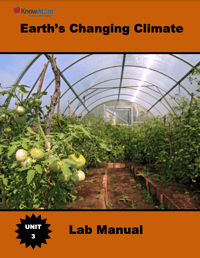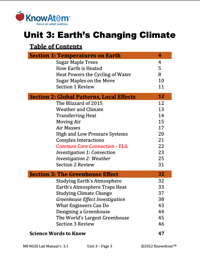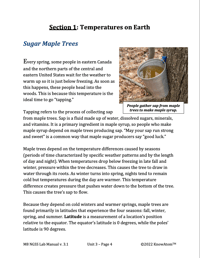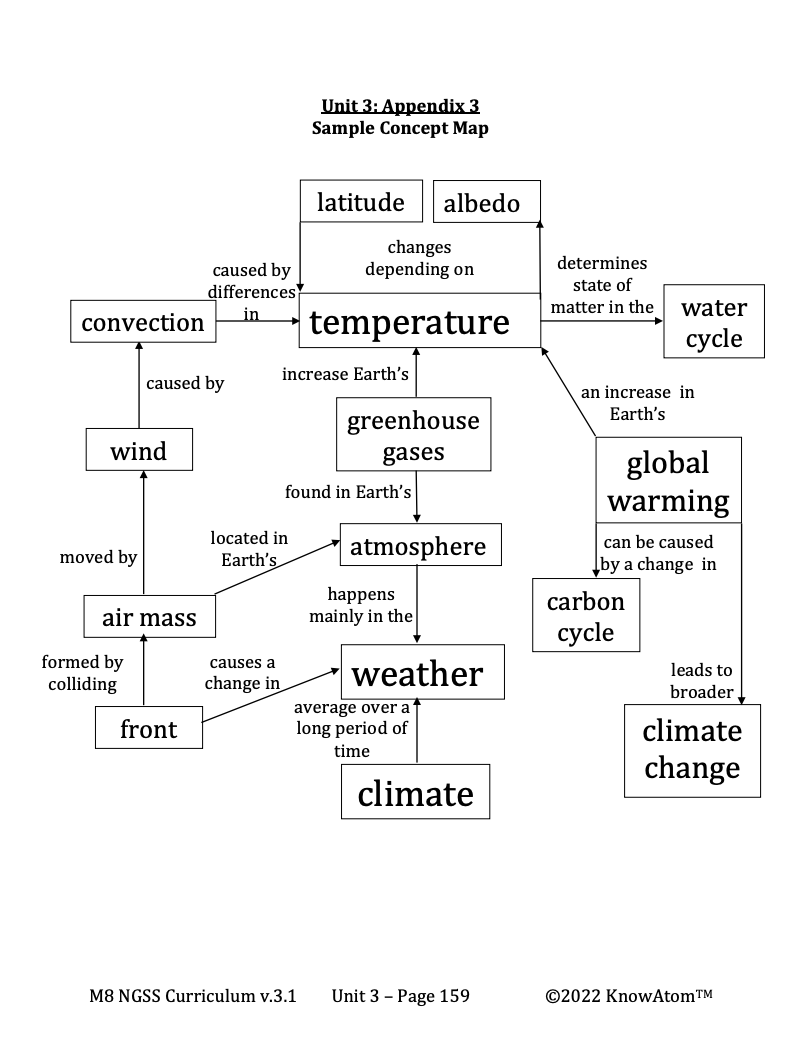Science background provides teachers with more in-depth information about the phenomena students explore in this unit. Below is an excerpt of the science background section on the greenhouse effect.
Global Warming & Climate Change
The interconnectedness of Earth’s systems means that a change in any one component of the climate system can influence the entire planet. Because of this, scientists believe that in recent decades, the increasing amount of carbon dioxide in the atmosphere has been fundamentally altering Earth’s climate.
Throughout Earth’s history, the climate has undergone dramatic changes. Ice ages have occurred at least five times in Earth’s history, all within the last 2.5 million years. An ice age is a global climate marked by long periods of cold temperatures that cause glacial formation and expansion. The ice ages were all followed by warming temperatures, which caused the glaciers to retreat toward higher altitudes and latitudes.
Scientists believe that since the 1800s, the concentration of carbon dioxide worldwide has increased from approximately 280 parts per million (0.028 percent) to around 365 parts per million (0.0365 percent). The increase may seem small, but it means that every year, about 3 billion metric tons of carbon dioxide are added to the atmosphere.
As more greenhouse gasses are put into the atmosphere, more infrared radiation is absorbed, which means that less heat escapes into space. In correlation, climatologists have detected a small but steady increase in global average temperatures over the last few decades. Six of the last ten were the hottest years on record. This is called global warming—the rise in global average temperature near Earth's surface
Scientists believe that global warming is caused mostly by increasing amounts of greenhouse gasses in the atmosphere, and is causing climate patterns to change. Climate change refers to any significant change in the average weather in a location over 30 years or more, including changes in temperature, precipitation, or wind patterns.
The Carbon Cycle
Scientists have focused much attention on the role of carbon dioxide in climate change. The carbon dioxide molecule— made up of one carbon atom and two oxygen atoms—is part of the carbon cycle, the circulation and transformation of carbon back and forth between living things and the environment.
Just like water, carbon is continuously exchanged and recycled throughout the environment. Anything that releases carbon dioxide into the atmosphere is called a source. Anything that absorbs and holds carbon dioxide is considered a sink. Over geologic time, carbon dioxide sources and sinks generally balance through the carbon cycle.
Carbon can cycle in short-term and longer-term fluctuations. For example, plants remove large amounts of carbon dioxide from the atmosphere as they photosynthesize and grow. This is a seasonal cycle. Respiration from both plants and animals, as well as decomposition of all organic material, release carbon dioxide back into the atmosphere.
Oceans also play an important role in the carbon cycle, continuously exchanging carbon dioxide with the environment. Oceans store about 50 times more carbon dioxide than is in the atmosphere. Increased carbon dioxide in the ocean changes the water, making it more acidic, which harms ocean creatures.
Human activities, primarily burning fossil fuels, producing cement, and agriculture, all increase the levels of carbon dioxide in the atmosphere. Scientists believe that the significant increase in greenhouse gasses is disrupting the carbon balance and as a result, changing Earth’s climate.
Studying Climate Change
Climate science is a challenging field because no one variable is responsible for causing Earth to warm or cool. Scientists research the climates of the past in an effort to better understand and predict climate change.
Climate science is a collection of averages across many regions and time periods. The best sources of long-term temperature data are geological materials such as ice cores, ocean sediments, and tree rings. Ice cores are used to study climate patterns of the past 750,000 years. Meanwhile, a worldwide network of carbon dioxide monitoring stations currently tracks the Earth's rising carbon dioxide levels.
The data show a strong correlation between temperature and the concentration of carbon dioxide in the atmosphere over the past several hundred thousand years. When the carbon dioxide concentration goes up, temperature goes up. When the carbon dioxide concentration goes down, temperature goes down. However, it is not easy in science to prove a cause- and-effect relationship between carbon dioxide and climate, given the number of variables that influence climate. Despite the complexities, there is widespread agreement among scientists that the rising global temperatures over the last hundred years is the result of increasing amounts of greenhouse gasses that are trapping heat.










